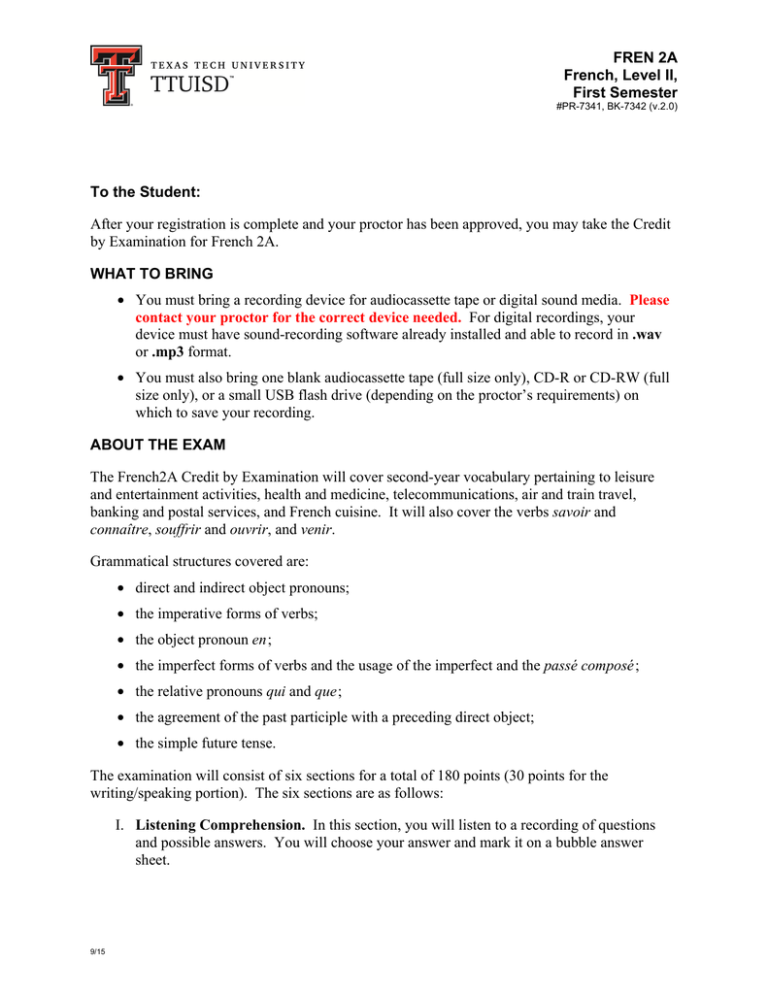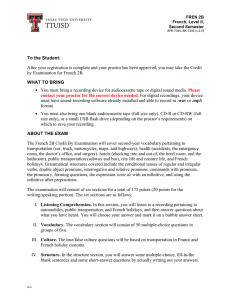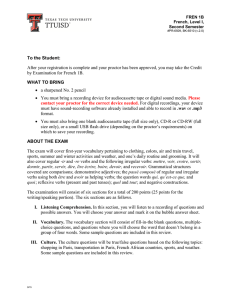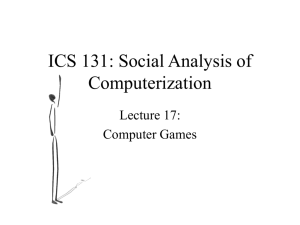FREN 2A French, Level II, First Semester To the Student:
advertisement

FREN 2A French, Level II, First Semester #PR-7341, BK-7342 (v.2.0) To the Student: After your registration is complete and your proctor has been approved, you may take the Credit by Examination for French 2A. WHAT TO BRING • You must bring a recording device for audiocassette tape or digital sound media. Please contact your proctor for the correct device needed. For digital recordings, your device must have sound-recording software already installed and able to record in .wav or .mp3 format. • You must also bring one blank audiocassette tape (full size only), CD-R or CD-RW (full size only), or a small USB flash drive (depending on the proctor’s requirements) on which to save your recording. ABOUT THE EXAM The French2A Credit by Examination will cover second-year vocabulary pertaining to leisure and entertainment activities, health and medicine, telecommunications, air and train travel, banking and postal services, and French cuisine. It will also cover the verbs savoir and connaître, souffrir and ouvrir, and venir. Grammatical structures covered are: • direct and indirect object pronouns; • the imperative forms of verbs; • the object pronoun en; • the imperfect forms of verbs and the usage of the imperfect and the passé composé; • the relative pronouns qui and que; • the agreement of the past participle with a preceding direct object; • the simple future tense. The examination will consist of six sections for a total of 180 points (30 points for the writing/speaking portion). The six sections are as follows: I. Listening Comprehension. In this section, you will listen to a recording of questions and possible answers. You will choose your answer and mark it on a bubble answer sheet. 9/15 II. Vocabulary. The vocabulary section will consist of multiple-choice questions, matching exercises, and questions where you will choose the word that doesn’t belong in a group of four words. III. Culture. The true/false culture questions will focus on French museums, French cuisine, telecommunications, and train travel in France. IV. Reading Comprehension. In this section, you will read a short passage in French and answer comprehension questions in English. V. Structure. In the structure section, you will answer fill-in-the blank sentences by actually writing out your answers. This section will focus on grammatical concepts and verb usage. VI. Writing and Speaking Proficiency. In this section, you will be asked to write five to seven sentences on your choice of two out of three prompts. You will then read your answers aloud and record it on your own recording medium (see “What to Bring” on the first page of this document). You will have three hours to complete the exam. The examination is based on the Texas Essential Knowledge and Skills for this subject. Since questions are not taken from any one source, you can prepare by reviewing any of the stateadopted textbooks that are used at your school. The textbook used with our French 2A course is Glencoe French II, Bon Voyage! from McGraw-Hill Companies, Inc. (2005). The practice exam included in this document will give you a model of the types of questions that will be asked on your examination. It is not a duplicate of the actual examination. It is provided to illustrate the format of the exam, not to serve as a review sheet. Good luck on your examination! 2 FREN 2A Practice Exam Vocabulary Choose the answer that best completes the sentence. 1. Paul a un rhume. Il est __________. A. une allergie 2. Christophe a très mal à la gorge. Il a __________. B. des frissons 3. Miriam a la grippe. Elle a de la fièvre et __________. C. mauvaise 4. Martin n’est pas en bonne santé. Il est en __________ santé. D. une angine E. enrhumé 5. Anne a les yeux qui piquent. Elle a __________. For each group, choose the word that doesn’t belong with the other three. 6. A. B. C. D. une orange un pamplemousse un poivron rouge un citron 7. A. B. C. D. des haricots verts des pommes des carottes des épinards Structure Rewrite each sentence, replacing the direct object in bold with the correct pronoun. 8. J’invite mes amis. ___________________________________________________________________ 9. Je connais ce tableau. ___________________________________________________________________ 3 Complete each sentence with the correct present tense form of souffrir or ouvrir as indicated in parentheses. 10. Il ____________________ beaucoup, le malade. (souffrir) 11. Tu ____________________ la bouche quand le médecin t’examine. (ouvrir) Rewrite the following sentences, changing the verb in bold from present tense to future tense. 12. Mes parents font un voyage en Grèce. ___________________________________________________________________ 13. Je fais les courses ce weekend. ___________________________________________________________________ Culture Indicate whether each statement is true or false. 14. Le Louvre est un ancien gare qui est devenu musée célèbre. 15. Les fruits de mer sont très populaires en Bretagne. 4 FREN 2A Practice Exam Answer Key 1. E 2. D 3. B 4. C 5. A 6. C 7. B 8. Je les invite. 9. Je le connais. 10. souffre 1. ouvres 12. Mes parents feront un voyage en Grèce. 13. Je ferai les courses ce weekend. 14. false 15. true 5 Texas Essential Knowledge and Skills FREN 2A – French, Level II, First Semester TTU: FREN 2A CBE, v.2.0 TEKS: §114.21. Languages Other Than English, High School (One-Half Credit). TEKS Covered TEKS Requirement (Secondary) Subchapter C. High School Statutory Authority: The provisions of this Subchapter C issued under the Texas Education Code, §28.002, unless otherwise noted. §114.21. Implementation of Texas Essential Knowledge and Skills for Languages Other Than English, High School. The provisions of this subchapter shall supersede §75.62(a)-(g) and (k)-(o) of this title (relating to Other Languages) beginning September 1, 1998. (a) General requirements. (1) Levels I and II - Novice progress checkpoint can be offered in elementary, middle, or high school. At the high school level, students are awarded one unit of credit per level for successful completion of the level. (2) Using age-appropriate activities, students develop the ability to perform the tasks of the novice language learner. The novice language learner, when dealing with familiar topics, should: (A) understand short utterances when listening and respond orally with learned material; (B) produce learned words, phrases, and sentences when speaking and writing; (C) detect main ideas in familiar material when listening and reading; (D) make lists, copy accurately, and write from dictation; (E) recognize the importance in communication to know about the culture; and (F) recognize the importance of acquiring accuracy of expression by knowing the components of language, including grammar. (3) Students of classical languages use the skills of listening, speaking, and writing to reinforce the skill of reading. (b) Introduction. (1) Acquiring another language incorporates communication skills such as listening, speaking, reading, writing, viewing, and showing. Students develop these communication skills by using knowledge of the language, including grammar, and culture, communication and learning strategies, technology, and content from other subject areas to socialize, to acquire and provide information, to express feelings and opinions, and to get others to adopt a course of action. While knowledge of other cultures, connections to other disciplines, comparisons between languages and cultures, and community interaction all contribute to and enhance the communicative language learning experience, communication skills are the primary focus of language acquisition. (2) Students of languages other than English gain the knowledge to understand cultural practices (what people do) and products (what people create) and to increase their understanding of other cultures as well as to interact with members of those cultures. Through the learning of languages other than English, students obtain the tools and develop the context needed to connect with other subject areas and to use the language to acquire information and reinforce other areas of study. Students of languages other than English develop an understanding of the nature of language, including grammar, and culture and use this knowledge to compare languages and cultures and to expand insight into their own language and culture. Students enhance their personal and public lives and meet the career demands of the 21st century by using languages other than English to participate in communities in Texas, in other states, and around the world. (c) Knowledge and skills. (1) Communication. The student communicates in a language other than English using the skills of listening, speaking, reading, and writing. The student is expected to: (A) engage in oral and written exchanges of learned material to socialize and to provide and obtain information; 6 (B) demonstrate understanding of simple, clearly spoken, and written language such as simple stories, high-frequency commands, and brief instructions when dealing with familiar topics; and (C) present information using familiar words, phrases, and sentences to listeners and readers. (2) Cultures. The student gains knowledge and understanding of other cultures. The student is expected to: (A) demonstrate an understanding of the practices (what people do) and how they are related to the perspectives (how people perceive things) of the cultures studied; and (B) demonstrate an understanding of the products (what people create) and how they are related to the perspectives (how people perceive things) of the cultures studied. (3) Connections. The student uses the language to make connections with other subject areas and to acquire information. The student is expected to: (A) use resources (that may include technology) in the language and cultures being studied to gain access to information; and (B) use the language to obtain, reinforce, or expand knowledge of other subject areas. (4) Comparisons. The student develops insight into the nature of language and culture by comparing the student's own language and culture to another. The student is expected to: (A) demonstrate an understanding of the nature of language through comparisons of the student's own language and the language studied; (B) demonstrate an understanding of the concept of culture through comparisons of the student's own culture and the cultures studied; and (C) demonstrate an understanding of the influence of one language and culture on another. (5) Communities. The student participates in communities at home and around the world by using languages other than English. The student is expected to: (A) use the language both within and beyond the school setting through activities such as participating in cultural events and using technology to communicate; and (B) show evidence of becoming a lifelong learner by using the language for personal enrichment and career development. Source: The provisions of this §114.22 adopted to be effective September 1, 1998, 22 TexReg 4930. 7






